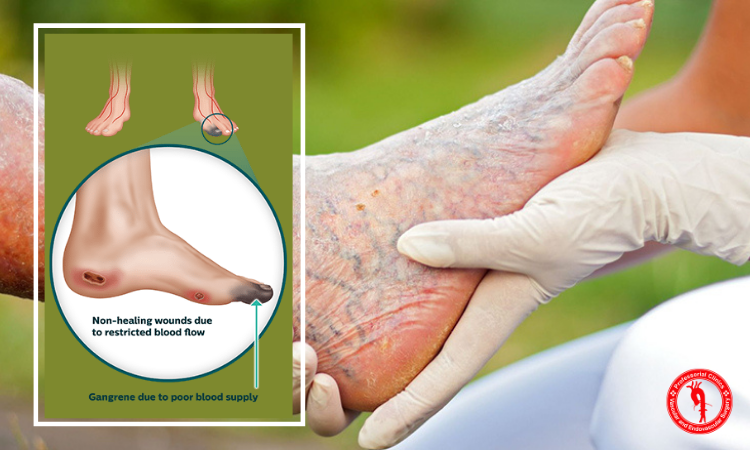Most of the vascular specialists have seen the most complex cases of critical limb ischemia or CLI. Hence, they have so many things to tell you or suggest to you how to know about the diseases and also its treatment.
There are many things that a patient needs to take care of if having CLI. Read this blog till the end to know what Critical limb ischemia is and whom you should consult – a vascular surgeon or cardiologist?
What is Critical Limb Ischemia?
CLI is a severe obstruction in the arteries. It is an advanced stage of peripheral arterial diseases that lowers the blood flow and leads to severe pain in the feet or toes or even skin ulcers or sores. The pain is so severe that it can wake up an individual at night. This pain also called ‘rest pain’, occurs in the legs and can be relieved temporarily by hanging the leg over the bed or walk around. Apart from this, the patient may feel numbness in his fee, thickening of toenails, and a lack of pulse in the legs or feet.
Causes
Now when you know what is CLI or Critical limb ischemia then let’s talk about the things that cause this disease and further will discuss the persons who can get affected with CLI.
CLI is the advanced stage of peripheral artery disease (PAD), which results from a progressive thickening of an artery’s lining (caused by a buildup of plaque). This buildup of plaque, also known as atherosclerosis, narrows or blocks blood flow, reducing circulation of blood to the legs, feet, or hands.
Risk Factors
- Age – The men who are above 60 years and the women after menopause.
- Diabetes
- High blood pressure
- Family history of vascular disease
- Smoking
- Sedentary lifestyle
- Obesity or overweight
What are the symptoms of critical limb ischemia?
As we have discussed that the patient feels severe pain in the feet, and this is the main feature of critical limb ischemia – rest pain. This means the patient will feel severe pain in the legs even when he’s not moving. But, other than this the common symptoms that tell you are a patient of CLI include the following: –
- Shiny, smooth, dry skin of the legs or feet
- Pain or numbness in the feet while not moving
- Absent or diminished pulse in the legs or feet
- Dry gangrene (dry, black skin) of the legs or feet
- Thickening of the toenails
- Open sores, skin infections, or ulcers that will not heal
You may have critical limb ischemia if you have any of the above-mentioned symptoms.
Treatment & Prevention
As the Critical Limb Ischemia lowers the blood flow in the arteries of the lower extremities so, it is a serious condition that requires immediate treatment. You should get immediate treatment to re-establish blood flow to the affected areas. The treatment for CLI can be complexed for some individuals and modified for an individual, but the overall goal is only to reduce the pain and improve blood flow to save the leg. The top priority of the vascular surgeons is to preserve the limb.
Treatments for CLI include the following:
Medications
When you will consult your vascular surgeon in Delhi (basically it treated under the supervision of the team of cardiologists, vascular surgeons, vascular specialists, wound specialist, and podiatrists) he can prescribe several medications initially to treat the pain. Medications can also prevent further progression of the disease and reduce the effect of other contributing factors like diabetes, high blood pressure, high cholesterol, etc. but the most importantly to reduce the pain. The surgeon can also prescribe the medications that prevent clotting or fight infections.
Endovascular Treatments
These treatments involve inserting a catheter into the artery. It’s actually lest invasive but an angioplasty can be used to open blockages by placing small balloon introduced with a catheter into an artery. To reach the diseased portion of the artery. The balloon is inflated so it will inflate, stretch and open the artery to improve the blood flow. Then a metallic device named “stent” will be inserted to maintain the expanded artery so that the blood flow to the limb will be improved.
The other treatments include laser atherectomy. In this small bits of plaque are vaporized by the top of a laser probe.And a rotating cutting blade is used to physically remove plaque from the artery is ‘directional atherectomy’.
Arterial Surgery
When the endovascular therapy is not favorable for the treating arterial blockages, then the surgeon go for arterial surgery. Through the surgery arterial diseases is removed or bypassed either with a vein from the patient or a synthetic graft.
But, you must know that treatment of CLI depends on the severity of the disease and many specific parameters. If you are having ulcers, pain in the legs or feet when walking or even while resting then you should see a vascular specialist as soon as possible. You will get the right treatment on right time as soon as the disease will be diagnosed with less serious consequences.
Vascular Specialist for Critical Limb Ischemia Risk Factor Management
People often get confused whether they should approach a cardiologist or vascular surgeon for CLI. But, one should consult vascular disease specialist who are skilled in the medical aspects of vascular disease treatment and help you get recovered easily and quickly. It is also important to select the right and experienced surgeon who can help patients by closely monitoring and better managing diseases or conditions that affect vascular health. Such specialists can help in vascular issues and other conditions from increasing by controlling cholesterol, diabetes, hypertension issues, etc. Finally we would say that choose the one surgeon that can make you feel comfortable about your vein and treatment.

